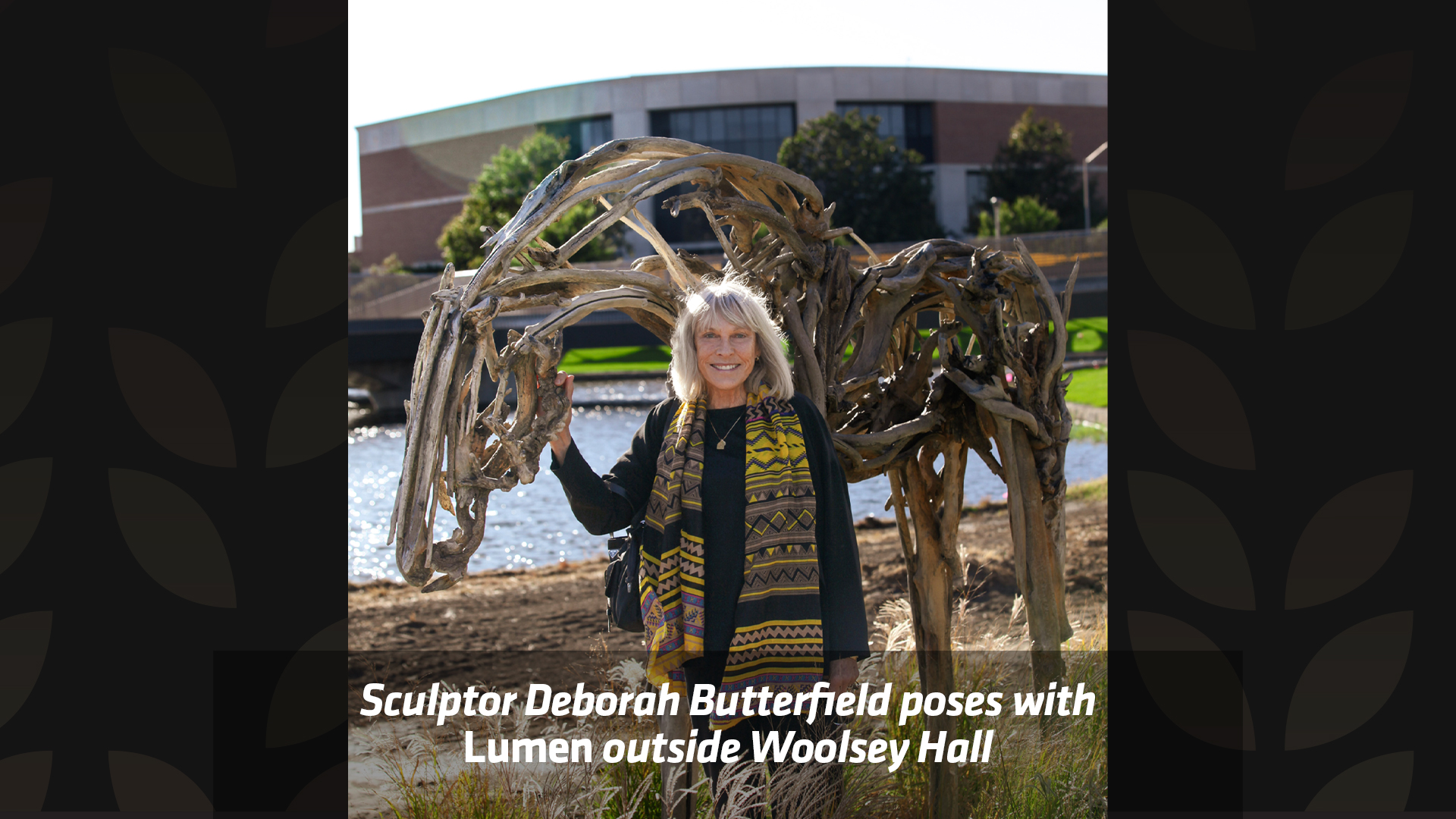Woolsey Hall, the home of the W. Frank Barton School of Business at Wichita State University, has unveiled its first sculpture to join the Ulrich Museum of Art’s world-class Martin H. Bush Outdoor Sculpture Collection. Lumen, the cast bronze sculpture of a horse created initially out of found wood, stands near the serene pond that stretches around the southern wall of Woolsey Hall. The art serves as a focal point for all visitors to the landscaped public space.
“This sculpture is a beautiful complement to Woolsey Hall area and the mission we cultivate at the Barton School,” said Dr. Larisa Genin, dean of the Barton School of Business. “This work of art embodies experimentation, innovation, openness, opportunity and diversity. It is first-class art for a first-class business school.”
The sculpture was created by renowned American sculptor, Deborah Butterfield, and is her first piece on public display in the state of Kansas.
Butterfield is known for her work depicting horses made from found objects. Lumen, which means “light” in Latin, was carefully created using sticks and found pieces of wood, cast in bronze, reassembled, and welded together. Its calm and peaceful presence is intended to provide opportunities for individual reflection and conversation for all who visit.
“We are very excited to continue to bring prominent contemporary sculptures from diverse artists such as Deborah to Wichita State,” said Vivian Zavataro, the newly appointed Executive and Creative Director of the Ulrich Museum of Art. “Her sculptures are quiet but poignant reminders of the interconnectedness of humans and members of the animal kingdom.”
Butterfield’s work can be found in dozens of public collections, including numerous major American museums such as the Art Institute of Chicago, Baltimore Museum of Art, Brooklyn Museum, Cincinnati Art Museum, Dallas Art Museum, Denver Art Museum, Hirshhorn Museum and Sculpture Garden, Metropolitan Museum of Art, Nelson-Atkins Museum of Art, San Francisco Museum of Modern Art, Smithsonian American Art Museum, and Whitney Museum of American Art. Her work can also be found in the collections of many American university art museums, including those at Stanford, Arizona State University, University of California Berkeley, Bowdoin College, Colby College, Wellesley College, University of California Davis, UCLA, Whitman College, and Yale University.
“The Martin H. Bush Outdoor Sculpture Collection has become an integral and powerful part of our campus experience,” said Dr. Richard Muma, president of Wichita State University. “Lumen matches the beauty, ingenuity, and distinction of Woolsey Hall and the differences our students and faculty are set to make on campus and beyond.”
About the W. Frank Barton School of Business
Located in Kansas’ business hub and with significant ties to the business community, the W. Frank Barton School of Business provides extensive applied learning opportunities. With in-person and online options, Barton School undergraduate and graduate programs are tailored to transform the lives of its students. It also holds a double AACSB accreditation for business and accounting, which puts it in the top 1% of business schools worldwide. The Barton School was established as the university’s College of Business Administration and Industry in 1926 and has thousands of graduates around the world.
About the Ulrich Museum of Art
The Edwin A. Ulrich Museum of Art is the university art museum of Wichita State University.
Open since 1974, it holds a nationally significant collection of approximately 6,700
works of modern and contemporary art that span the 20th and 21st centuries and include
the nationally recognized Martin H. Bush Outdoor Sculpture Collection. The Ulrich
is a vital community resource that supports intellectual inquiry, teaching, and lifelong
learning on the WSU campus and in the community.
Museum direction is guided by the Ulrich Advisory Board, composed of no more than 25 university and community leaders. The WSU Foundation, owns and ensures the Museum’s art collection.


